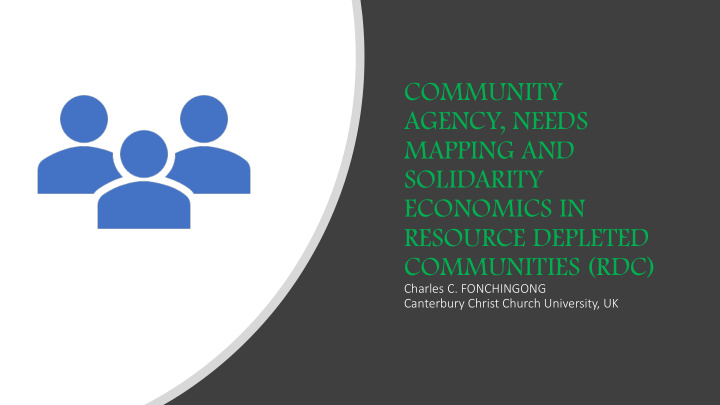



COMMUNITY AGENCY, NEEDS MAPPING AND SOLIDARITY ECONOMICS IN RESOURCE DEPLETED COMMUNITIES (RDC) Charles C. FONCHINGONG Canterbury Christ Church University, UK
Thesis for Solidarity Economics: • Backdrop of shrinking budgets for most social welfare departments in most of sub Saharan Africa • Shortfall of essential services • Village associations, community- driven solidarity heralded as Context of alternative pathway Study • Viability of SSE as a model for resuscitation in resource constrained communities warrants further investigation due to escalating levels of spatial, social, political and economic inequalities
THEORETICAL PROPOSITION Social theory, Social capital and livelihood diversification In social economy theory, social enterprises facilitate sustainable local development by including relational assets which embody social capital, bearing on social innovation processes and dynamics (Kim and Lim 2017, Fonchingong C. 2018) Solidarity conceptualized as new ways of mobilizing scarce resources for everyday living, anchored on principles of self-help; inward looking strategies organized and re-distributed for communal benefit The triggers and stressors; the characteristics of the system that facilitate action, typified by the social structure cannot be discounted Social and spatial dynamic elements, embedded in these theories, cultural and relational assets are crucial in understanding the utility, and sustainability of solidarity economics
METHODOLOGY AND CONTEXT Qualitative case study uncovers the basis of solidarity economics within a resourceful village development association, a bedrock for strategizing and re-invention of peripheral solidarity for livelihood improvements for rural communities operating at the margins in North West Cameroon Epistemological standpoint: ecological experience of growing up, and coping within a resource constrained environment Lethargic governance and limited state intervention in livelihoods, particularly in rural areas Semi structured interviews- 71 participants and information gleaned from key informants, NACDA documents and secondary sources Foundations of solidarity economics embedded in livelihoods improvement - participants’ narratives
Findings: VDA tiered Solidarity Framework Njangis and Credit groups Quarter development Cultural assets Unions Village Development Association (community solidarity and Womens' agency ) Relational Empowerment networks centres Cooperatives (farmers, Diaspora consumers, networks credit)
Participants’ Narratives: Funnelling Solidarity VDA: ‘ we need to constantly look inside, help each other in the community and seek to continually build bridges of mutual help and assistance, that is the only way we can instil a spirit of common identity and vision’ . Cooperatives: ‘ within our farming cooperatives, we do help one another during planting and harvesting, we rotate in terms of preparing the fields and we take turns to harvest the crops ’. Cultural Assets: the palace is a gravitational force in social development and we as a community look up to it with a sense of pride and identity’ . Social enterprise: ‘we hope one day we can have a big farming cooperative that will sell our goods to international markets, which will give us more money to solve other pressing problems’ Diaspora: ‘ njangis are an umbrella for us to gather, pool together resources and enable members to carry out individual projects. We equally raise funds and support development projects back in the homeland’ Women’s empowerment centres: ‘the empowerment centres is your place to share ideas on how we can expand our business; we also learn new skills and ways of doing things that will make our business grow. The centre gives us the opportunity to meet and know more on meal preparation, traditional dress making and tailoring and so on’
IMPLICATIONS FOR POLICY Needs mapping Utility of Cultural Community and tangible and relational Social Enterprise agency benefits assets Social services and Rural development Co-production evidence based policy linked to analysis SDGs
CONCLUDING POINTS VDAs create a platform for self-help, where social relationships are formed and strengthened, building trust, and reciprocity Members rely on annual development levies and njangis to build scarce financial resources, these forms of capitalisation are not sustainable, and on a long-term footing in meeting mapped needs Social capital built on an incremental basis facilitates the engagement in social action to achieve a collective goal - the very essence of solidarity economics
Cooperatives
Pupils – Recipients of f Books
Recommend
More recommend